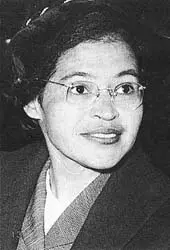Rosa Parks
The civil rights movement in the United States was at the edge of happening in 1955. During that time, Black Americans had specific seating positions in the back of all busses and public transportation and were required to give up their seats if the transportation was full when a white person needed a seat. When Rosa refused to give up her seat, she was arrested and put in jail. This single situation prompted an official launch for the Montgomery bus boycott and the civil rights movement across the nation.


Rosa was the daughter of two former slaves and was raised in a home that encouraged freedom without consideration of race. She was a grass roots activist in the pursuit of the rights for African Americans. She experienced racial prejudice every day as she walked to school because the school buses wouldn’t take black Americans. The schools for African Americans were also shoddy and didn’t have very good supplies.

Rosa married Raymond Parks at the age of 19. Raymond was a member of the NAACP (National Association for the Advancement of Colored People). Rosa’s interest in equality allowed her to join the NAACP and work in the Montgomery, Alabama chapter as well as the position of secretary to the chapter’s President.

The Montgomery City Code allowed a bus driver to demand and then physically move any person, regardless of color, to relocate to another seat. This law enforced the existing belief that Black Americans be required to board the bus, pay the fare and then get off of the bus and re-board at the back. The day that Rosa refused to move, not just because she was tired after a full day’s work, but because she was tired of ‘giving in’, it verified her belief as an activist to demand equality for all people.

The evening that Rosa was arrested, the President of the NAACP organized a boycott (not support) of public transportation for December 5, 1955. The NAACP handed out pamphlets, took ads in the paper and sent the word out that people were to stay at home, not take public transportation, take a cab or walk to support the cause of equality. The estimated 40,000 Black Americans supported the boycott and buses appeared, almost completely empty. The boycott continued for a number of months, causing financial problems for the city.

When Rosa went to court, there were 500 people waiting outside to support her. Her fine was small, but the message had been sent loud and clear. Unfortunately, there were those in the community that fought back, burning down African American churches and the homes of the leading supporters, including the home of Martin Luther King, Jr and the President of the NAACP.

Black Americans followed up with legal action and a lawsuit began to fight the laws. In June, 1956, the court ruled that the law supporting the segregation (also known as “Jim Crow” laws) were unconstitutional and could not be enforced.

Even though Rosa had become a symbol of the civil rights movement, her life was affected and she lost her job due to her celebrity and her husband was fired when his boss required that he not speak with his own wife during the trial. The Park family relocated to Detroit, Michigan where Rosa was receptionist and secretary in the congressional office of U.S. Representative, John Conyer and was also on the Planned Parenthood Federation of America board.

Rosa published her autobiography book: “Rosa Parks: My Story” in 1992 and then her second book of memoirs “Quiet Strength” in 1995. She received an incredible number of awards, including the NAACP highest award, and the Spingarn Medal; the Martin Luther King, Jr. award. President Bill Clinton awarded her the Presidential Medal of Freedom in 1996, which is the highest honor that is awarded by the U.S. executive branch. Rosa was also given the highest award given by the U.S. legislative branch, Congressional Gold Medal in 1997, and in 1999, Rosa Parks was named on the TIME magazine list of “The Top 20 most influential People of the 20th Century”.

At the age of 92, Rosa passed away in Detroit, Michigan. Memorial services were held at the Capitol Rotunda in Washington, D.C. and was attended by over 50,000 people. She was buried at the Detroit Woodlawn Cemetery and the chapel was renamed the Rosa L. Parks Freedom Chapel.




